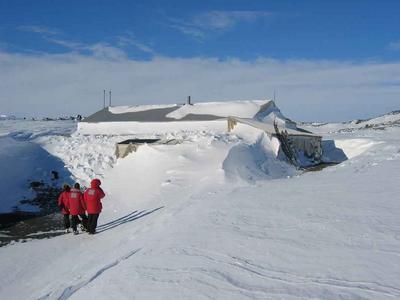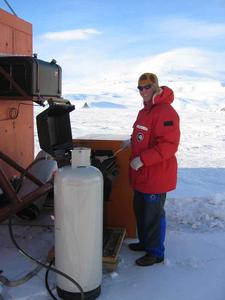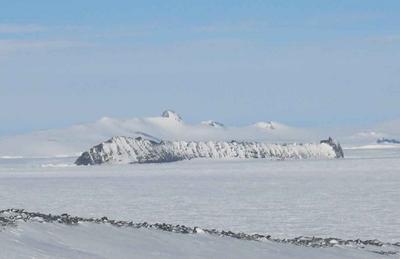18 October, 2003
Our survey of the study area continued today, as we visited the North
Base, Turk's Head, Tryggve Point, and Inaccessible Island's seal
colonies. We followed the eastern coastline as far north as Cape
Evans-there are often a few seals here later in the season. Cape
Evans is the northernmost boundary of the study area. There is a map
of our study area included with yesterday's journal entry-so you can
get an idea of the geography of the area.
North Base is at the north side of the Erebus Glacier Tongue. It
gets its name from its location at the base of the glacier. Access
is difficult from the sea ice-we must cross over snow and ice to
reach the crack where the seals access the ice' surface for pupping.
On today's trip, we flagged the route that we will be using during
the season, careful to avoid cracks and crevasses. It was difficult
to believe that seals would be back there-but when we reached the
main ice crack area we could see they had been there. There was only
one seal on the ice today, but as the season progresses, more will be
in this protected area.
From North Base, we traveled north along the coast to check the
colony at Turk's Head. Turks Head is one of the largest seal colonies
in the study area-with up to 200 seals during the peak of the season.
There were a few seals on the ice, but there will be many more once
pupping really gets going. Next to Turks Head is Tryggve Point, named
after a Norwegian member of Robert Scott's South Pole expedition, and
home to another seal colony.
Cape Evans is the location of the hut where Scott and his men stayed
as they readied themselves for the trip to the South Pole. In 1912
Shackleton's crew from the ship Aurora also took advantage of this
hut when their ship blew away in a storm (the anchor is still lying
near the hut) and they were forced to scrounge in the area around the
hut for supplies to continue their mission of laying out food depots
for his Tran Antarctic Expedition. Standing near the hut on a clear
and cold spring day, I can only imagine what it must have been like
for both parties during the long Antarctic winters.
We finished our day at the seal colony at Inaccessible Island. There
were a few adult seals there, but no pups. Two of the adults needed
tagging, so we were able to practice the seal bag dance and give them
tags. From there, we crossed to the flagged sea ice road and headed
back to camp. Our timing was excellent. We returned to camp as the
winds increased and visibility decreased.
A word about driving snowmobiles across sea ice. In case you're
picturing a smooth glassy surface, it's time to absolutely revise
that image. The sea ice is covered with irregular hard-packed
wind-blown mounds of snow known as sastrugi. Often the best route
between two points is anything but a straight line. It's exciting
driving, to say the least-bumping through the snow mounds, picking a
route that maximizes smooth snow and minimizes bone-jarring drops off
the ends of snow mounds. Definitely 4-wheel drive style
snowmobiling! When we reach the packed sea ice road, it's a pleasure
to sit back and drive along its relatively smooth surface.
Back at camp, we cleaned up tools, drank hot beverages to warm us up,
and looked over our bounteous larder to plan the evening's menu. How
about grilled halibut with a rice and vegetable pilaf? While the wind
speeds gusted over 30mph, and wind chill dropped to -40F, Darren set
up what was, without a doubt, the southernmost propane barbecue grill
in use this evening. Bon appetit!
Daily Haiku:
Amazing vistas
Erebus steams, seals bellow
Clear blue, icy cold

Our sea ice home

Flagging the North Base route

A view of Mt. Erebus

Scott's Hut at Cape Evans

The southernmost BBQ in the world

The view back towards camp. Our camp is on the ice near the mid-point of Big Razorback Island.
Contact the TEA in the field at
.
If you cannot connect through your browser, copy the
TEA's e-mail address in the "To:" line of
your favorite e-mail package.
|
